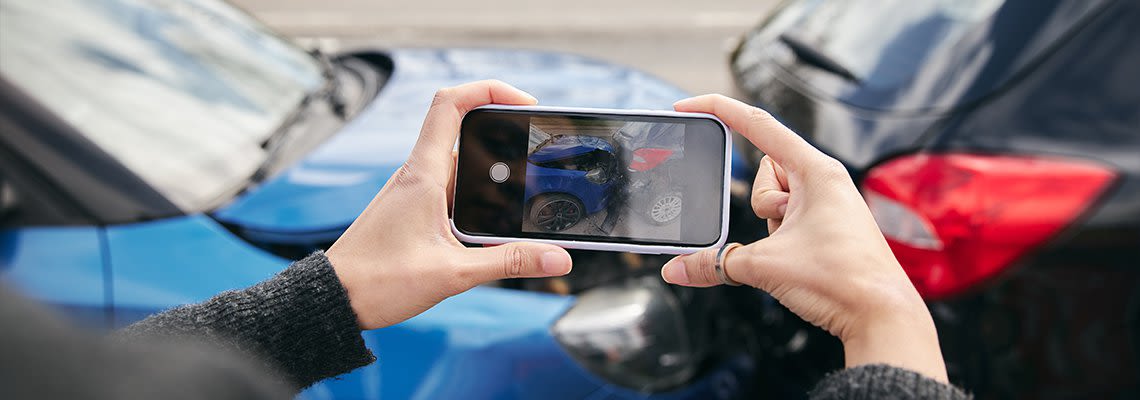
Photograph Evidence of A Traffic Accident
Providing evidence of how a traffic accident occurred is crucial to protecting your rights after a traffic accident. Taking pictures to show the accident scene before you move your vehicle and while waiting for a police officer can help the insurance company process your claim. The pictures can show how the vehicles collided, the skid marks from the vehicles, the current weather, the traffic signals, the damage to the vehicles, the injuries to the drivers, and other pieces of evidence that may be important. The photographs taken will preserve proof for insurance companies when you make your claim.
Take Pictures Before the Vehicles are Moved
You should take pictures after the accident, but before the vehicles are moved to show how the vehicles impacted each other. While photos showing damage to the vehicles are important for an insurance company to evaluate accident claims, pictures of the vehicles before they have been moved is important to assess who is at fault for the accident. These pictures resolve much of the argument from drivers about who was at fault and provide proof of what actually occurred. The pictures preserve the accident scene.
Photograph the Tire Skid Marks
The skid marks from the vehicles will show the driver’s actions immediately preceding the accident. You should photograph the skid marks to show if the driver slammed on the brakes and was paying attention. The absence of skid marks can show a driver was not paying attention. The insurance companies will want these pictures to determine who is at fault for the accident. Taking pictures of the skid marks before the vehicles have been moved, if it can be done safely, better illustrates the vehicle and driver’s actions before the accident.
Document the Weather Conditions
Photographs will show what the weather was like during the accident. If rain played a factor in the accident or even possibly contributed, you should take a picture of the slick roads. Taking pictures of rain puddles and showing their distance from the accident can show a reason for the accident. Pictures of the road conditions during a snowfall can also be helpful to assess fault. Capture pictures of ice patches to evaluate fault. Capturing these pictures immediately after the accident is important because weather conditions may change or a snowplow may change the road conditions.
Photograph Traffic Lights and Traffic Signs
You should also take pictures of any traffic lights or traffic signs that can be helpful to understand what happened. Traffic signs should be photographed to show what was or was not occurring prior to the accident. For example, if two vehicles collided with each other while one was merging onto the highway, the merging vehicle might have had a yield sign. The yield sign can be crucial to proving fault. Also, photographing a stoplight can prove neither driver was at fault. Assume the vehicles collided at a stoplight while one vehicle was turning, but the stoplight had no turn signal or the turn signal was not working. The city could be at fault in this situation.
Take Pictures of the Vehicle Damage
You should photograph the vehicles’ damage before and after moving the vehicles. You should photograph all the vehicles involved in the accident to help the insurance companies determine liability. Pictures showing the vehicles’ damage prior to moving the vehicles will show the damage that actually resulted from the accident. A vehicle could have a dent in the side, but the current accident did not cause the dent or involve that side of the vehicle. After moving the vehicle, pictures of the damage should be taken again. The insurance company will need pictures depicting the damages from every angle. Pictures should be taken of the exterior and interior of the vehicle.
Photograph Your Injuries
In addition, you should also photograph all your injuries. These pictures will be useful to determine your medical bills or pain and suffering expenses. If you have a passenger in your vehicle, take pictures of your passenger’s injuries as well. You should take pictures of your injuries immediately after the accident and the days following the accident because some bruising might not immediately appear. If you are too injured to take pictures, have someone else take pictures on your behalf. The medical providers can also help to take pictures of your injuries.
Take Pictures of Miscellaneous Items
You should take pictures of any item that could be important to determine fault in the accident. You cannot take too many pictures. You should photograph the debris from vehicles and any other damaged structure caused by the accident, i.e., a building, curb, street sign, etc. Also, take pictures of damaged structures that may have played a factor in the accident, i.e., a crumbling road, pothole or an object in the roadway. Take photos of other drivers involved in the accident, any passengers, and any witness in case the other driver tries to conceal the number of passengers or other information. Also, take pictures of the other driver’s license and insurance card.
Photographs can prevent insurance companies from denying liability. The more photographs you take immediately following the accident, the less complications you will face when securing your claim. Your pictures will help attorneys and insurance companies reconstruct the scene. Taking pictures of the accident preserves the scene and prevents other drivers from inventing differing accounts of what happened.
